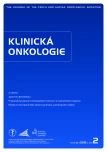Prognostic Significance of Morphology in Multiple Myeloma
Authors:
M. Al-Sahmani 1,2; I. Trnavská 1; M. Antošová 1; L. Antošová 1; J. Kissová 1; B. Kaisarová 2; Z. Adam 1,3; A. Buliková 1; M. Penka 1; R. Hájek 1,2,3,4
Authors‘ workplace:
Oddělení klinické hematologie, FN Brno
1; Babákova myelomová skupina, Ústav patologické fyziologie, LF MU Brno
2; Interní hematoonkologická klinika, FN Brno
3; Laboratoř experimentální hematologie a buněčné imunoterapie, Oddělení klinické hematologie, FN Brno
4
Published in:
Klin Onkol 2012; 25(2): 103-109
Category:
Original Articles
Overview
Backgrounds:
Multiple myeloma is the second most common hematological disease caused by clonal proliferation of B cells. Evaluation of number of plasmocytes in the bone marrow is still one of the basic diagnostic criteria.
The aim of this study was to verify if this evaluation has prognostic value even in the era of new drugs.
Material and Methods:
Two groups of MM patients were enrolled in this study. The group T – 45 newly diagnosed MM patients who underwent treatment with thalidomide. Group B – 86 patients in first relapse of MM without autologous transplantation of bone marrow that were treated with thalidomide and bortezomib in various combinations. Percentage of subtypes of plasmocytes in the bone marrow was evaluated based on progressive analysis of nucleus, chromatin and nucleo-cellular ratio (N/C).
Results:
Mature plasma cells were found in 53.3% (group T) and 53.5% (group B) of patients; proplasmocytes I were found in 22.2% (group T) and 24.4% (group B) of patients; proplasmocytes II were found in 22.2% (group T) and 22.1% (group B) of patients and plasmablasts in 1% (group T) and 0% (group B). Patients who reached treatment response after first treatment had statistically significant number of proplasmocytes II when compared to group without treatment response (median 37% vs. 11%, p = 0.033). Group B patients with mature plasmocytes below 10% had significantly shorter overall survival than other patients when comparison of quartiles was performed. Group B patients with higher infiltration of proplasmocytes I than median of 15% had lower overall survival (median 50.3 months vs. 74.9 months, p = 0,024); the same was true for evaluation of proplasmocytes II (median OS 41.3 months vs. 74.9 months, p = 0,011).
Conclusion:
Numerical evaluations of plasma cells in the bone marrow remain basic diagnostic criteria of MM even in the era of new genomics analyses. More precise morphological evaluation of 8 subtypes of plasma cells brings important prognostic information that is necessary for new protocols for immunomodulatory drugs and proteasome inhibitors.
Key words:
multiple myeloma – plasma cell – morphology – survival – staging
This work was supported by grants of Ministry of Education, Youth and Sports of the CR LC06027, MSM0021622434, grants of IGA MZ CR NS10387, NS10406, NS10408, NT12130 and grant of The Czech Science Foundation GAP304/10/1395.
The authors declare they have no potential conflicts of interest concerning drugs, products, or services used in the study.
The Editorial Board declares that the manuscript met the ICMJE “uniform requirements” for biomedical papers.
Submitted:
2. 6. 2011
Accepted:
29. 8. 2011
Sources
1. Ščudla V, Adam Z. Diagnostický význam a úskalí hodnocení roztěrového preparátu kostní dřeně u mnohočetného myelomu. Vnitř Lék 2006; 52 (Suppl 2): 55–65.
2. Adam Z, Hájek R, Mayer J et al. Mnohočetný myelom a další mnoklonální gamapatie. 1. vyd. Brno: Masarykova univerzita 1999.
3. Adam Z, Bačovský J, Flochová E et al. Diagnostika a léčba mnohočetného myelomu – Doporučení vypracované Českou myelomovou skupinou a experty SR. Transfuze Hematol Dnes 2005; 11(1): 3–11.
4. Fonseca R, Bergsagel PL, Drach J et al. International Myeloma Working Group molecular classification of multiple myeloma: spotlight review. Leukemia 2009; 23(12): 2210–2221.
5. Greipp PR, Raymond NM, Kyle RA et al. Multiple myeloma: significance of plasmablastic subtype in morphological classification. Blood 1985; 65(2): 305–310.
6. Goasguen JE, Zandecki M, Mathiot C et al. Mature plasma cells as indicator of better prognosis in multiple myeloma. New methodology for the assessment of plasma cell morphology. Leuk Res 1999; 23(12): 1133–1140.
7. Tsuchiya J, Murakami H, Kanoh T. Ten-year survival and prognostic factors in multiple myeloma. Japan Myeloma Study Group. Br J Haematol 1994; 87(4): 832–834.
8. Mayer J, Starý J et al. Leukemie. 1. vyd. Praha: Grada Publishing 2002.
9. Lexová S, Buliková A et al. Hematologie pro zdravotní laboranty 1. díl. 1. vyd. Brno: IDVPZ 2000.
10. Al-Sahmani M, Trnavská I, Antošová M. Prognostický význam morfologického hodnocení nádorových buněk u mnohočetného myelomu. Blood (ASH Annual Meeting Abstracts) 2009; 114: Abstract 4889.
11. Adam Z, Hájek R, Mayer J et al. Mnohočetný myelom a další Monoklonální gamapatie. 1. vyd. Brno: Masarykova univerzita 1999.
Labels
Paediatric clinical oncology Surgery Clinical oncologyArticle was published in
Clinical Oncology

2012 Issue 2
Most read in this issue
- Agressive Fibromatosis: Genetic and Biological Correlations
- Aggressive Fibromatosis: Clinical Aspects
- Palliative Surgical Treatment of Tumors of Pancreas and Periampullary Region
- Thyroid Disorders in Women with Breast Cancer
